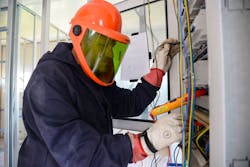You work for an electrical services firm that normally works at client facilities within a few miles of the home office. But to grow the company and provide consistent employment, the executive staff has begun sending the sales force out to within a 500-mile radius.
Your company recently landed its first contract with one of these “distant” clients and is counting on the referral to get more such clients. The client has a manufacturing plant about four hours from your home office. The work includes racking out some breakers, and also using a portable power analyzer on live equipment.
You and another electrician arrived onsite and got cleared through security. Your next step will be to unload equipment and get set up for the work.
The analysis done during the job planning showed that your arc flash PPE needs to be rated at 40 cal. But when you open your kit, you discover the helper packed a 20 cal kit instead. Your coworker checks his kit and finds the same problem. Under the old setup, this would not be a big problem; one of you would run back for the PPE or text the office to have a runner bring it to you.
You and your coworker discuss whether to proceed with the lower-rated PPE or delay the job by four hours until a runner can bring the correct PPE. You do have about an hour of other work you can do. The three hours of doing nothing will cause a schedule delay.
Your coworker says the client will respect the safety decision not to proceed until you have the correct PPE, and your company would not want a client who doesn’t. True, but the four-hour delay is still not going to go down well. You hash out some other pluses and minuses of this choice, in preparation for calling the home office to get a decision from them.
This approach has several problems. First of all, you can’t do the work without the correct PPE. Posing “go get it or delay” as the question poses the wrong question.
Second, an “either/or” decision is not what you need to solve this. Instead, you need to consider other possibilities. For example:
- Purchase the correct PPE from an electrical distributor near the plant. Downside: extra cost. But maybe you need that PPE anyhow, and helper sent 20 cal because that’s all you had; the office staff could verify. Upside: quick solution, get on with the job.
- Ask the customer if you can borrow, rent, or purchase the correct PPE from them. Downside: You’re letting the customer know you made a mistake. Upside: You’re letting the customer know you caught a mistake and you want to resolve it quickly.
- Inform the client of the problem, and ask for their help. Downside: You’re asking for a favor. Upside: You’re asking for a favor, a proven way to help build a relationship; people like to help other people.
When you’re faced with a safety dilemma, the worst possible choice is to pretend it’s not a problem. Any good solution involves owning the problem. A really great solution turns the problem into an opportunity. Think beyond simple either/or decisions.
And don’t forget to perform a “lessons learned” analysis. In this case, for example, each member of the crew that is going to a “distant” location needs to personally review the job kit to ensure it’s correct and complete. This needs to have a special focus regardng such things as PPE, special tools, and special materials that might not be readily available at remote locations. Had that been done here, the whole problem would have been prevented.
About the Author

Mark Lamendola
Mark is an expert in maintenance management, having racked up an impressive track record during his time working in the field. He also has extensive knowledge of, and practical expertise with, the National Electrical Code (NEC). Through his consulting business, he provides articles and training materials on electrical topics, specializing in making difficult subjects easy to understand and focusing on the practical aspects of electrical work.
Prior to starting his own business, Mark served as the Technical Editor on EC&M for six years, worked three years in nuclear maintenance, six years as a contract project engineer/project manager, three years as a systems engineer, and three years in plant maintenance management.
Mark earned an AAS degree from Rock Valley College, a BSEET from Columbia Pacific University, and an MBA from Lake Erie College. He’s also completed several related certifications over the years and even was formerly licensed as a Master Electrician. He is a Senior Member of the IEEE and past Chairman of the Kansas City Chapters of both the IEEE and the IEEE Computer Society. Mark also served as the program director for, a board member of, and webmaster of, the Midwest Chapter of the 7x24 Exchange. He has also held memberships with the following organizations: NETA, NFPA, International Association of Webmasters, and Institute of Certified Professional Managers.
